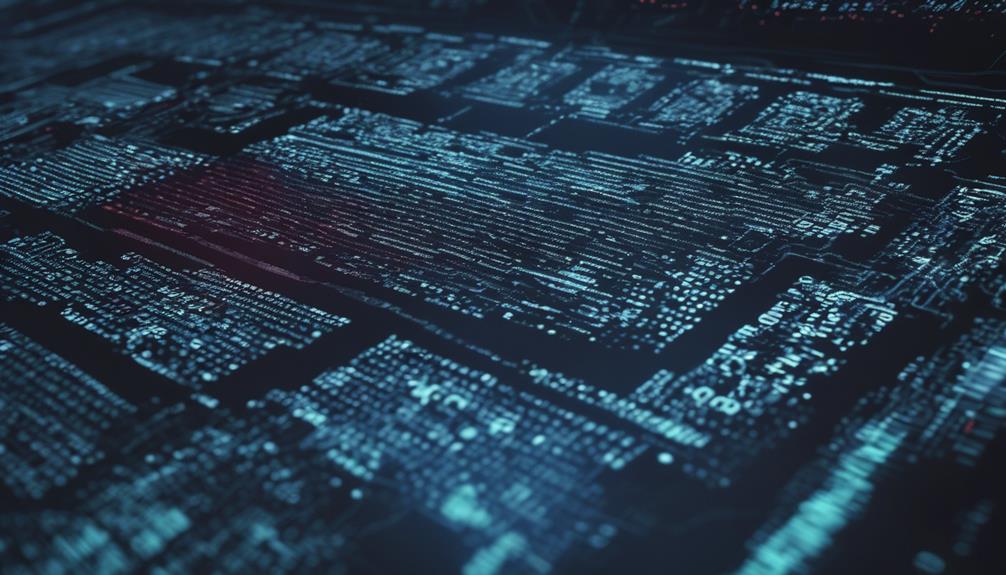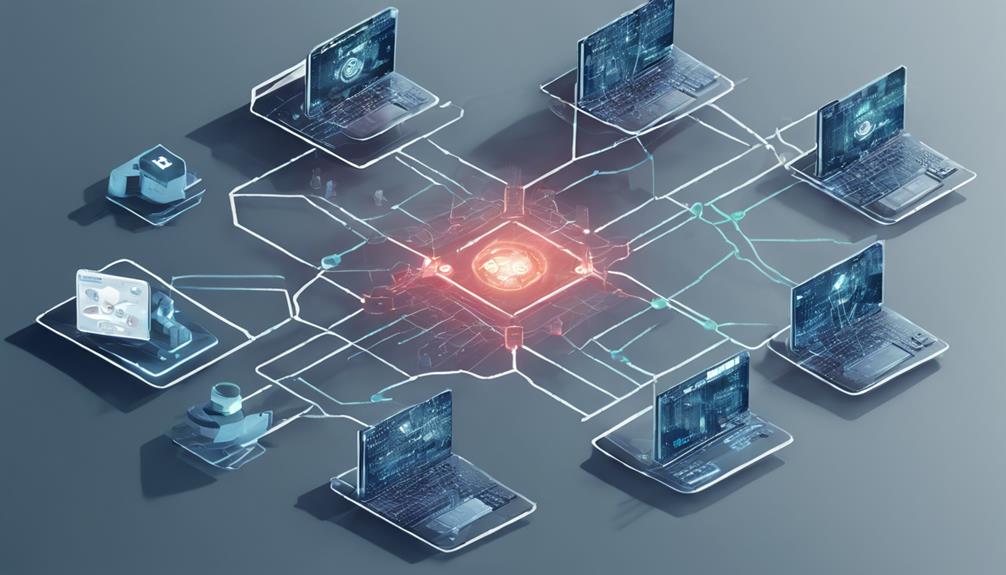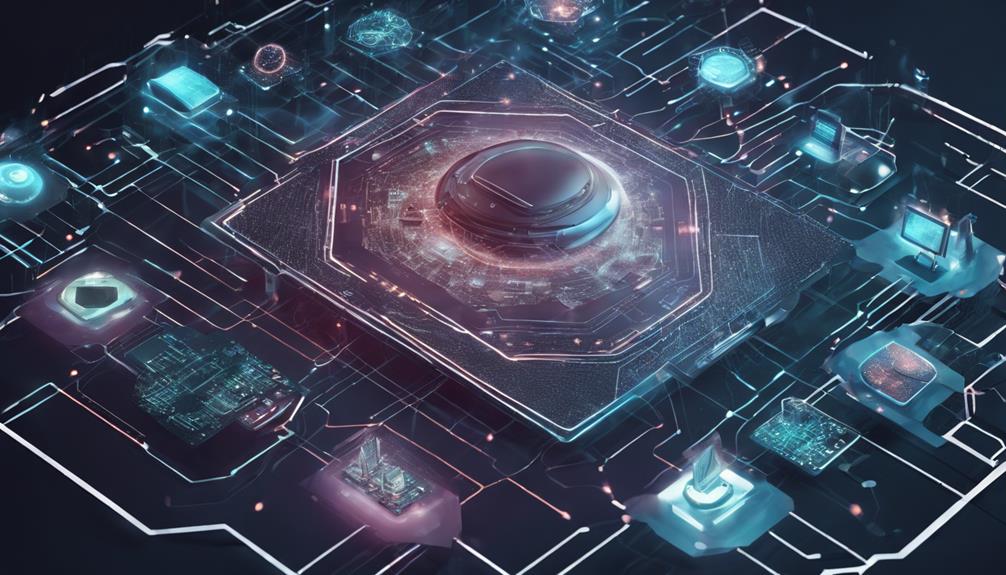Generative AI plays a vital role in cybersecurity by revolutionizing the field. It creates realistic training data, drives innovative security tool development, and enhances system defenses. This innovative technology facilitates proactive threat detection and accurately simulates cyberattacks. Benefits include pinpointing security weaknesses, testing defense efficiency with varied attack simulations, and providing insights into emerging cyber risks. It also aids in continuously improving security measures to stay ahead of evolving threats. By assisting in spotting unusual patterns, understanding vulnerabilities, and anticipating new threats, generative AI automates security tasks and prepares for unseen cyber threats. Explore the limitless uses of generative AI in cybersecurity.
Key Takeaways
- Generates realistic cyberattack simulations for training and testing.
- Enhances proactive threat detection capabilities.
- Identifies system vulnerabilities through varied attack scenarios.
- Automates security tasks and defense strategies.
- Enables preparation for emerging cyber risks with advanced AI.
Generative AI for Realistic Training Data
Generative AI plays an essential role in cybersecurity by enabling the creation of realistic training data that simulates various attack scenarios. This training data is invaluable for preparing security teams to recognize and effectively respond to potential threats.
By mimicking diverse attack scenarios, generative AI enhances the accuracy and thoroughness of security training, equipping professionals with the skills needed to combat evolving cyber threats.
Moreover, the realistic training data generated by AI facilitates the development and testing of cybersecurity tools and systems. These datasets serve as a crucial resource in refining security measures and ensuring the resilience of defense mechanisms against malicious activities.
Through the use of generative AI in creating training data, organizations can establish more robust and proactive cybersecurity protocols, staying a step ahead in the ongoing battle against cyber threats.
Innovative Security Tools Development

Advancements in cybersecurity are being driven by the development of cutting-edge security tools that leverage generative AI technology. These innovative security tools are instrumental in enhancing threat detection capabilities, allowing organizations to stay ahead of cyber threats effectively. By utilizing generative AI, these tools can simulate various cyberattack scenarios, pinpoint vulnerabilities, and fortify overall cybersecurity defenses. This proactive approach enables security teams to strengthen their security posture by addressing weaknesses before they can be exploited.
| Security Tools Development | Benefits of Generative AI |
|---|---|
| Simulate cyberattacks | Identify vulnerabilities |
| Enhance threat detection | Improve cybersecurity defenses |
| Proactively strengthen security posture | Stay ahead of evolving threats |
| Provide actionable insights | Utilize AI-generated data |
| Enhance response capabilities | Enable effective cybersecurity strategies |
The integration of generative AI in security tools not only revolutionizes threat detection but also empowers organizations with actionable insights to bolster their cybersecurity defenses.
Enhancing System Defenses With AI

In cybersecurity, AI plays an essential role in enhancing system defenses through threat detection and incident response.
By leveraging AI for threat detection, organizations can proactively identify and mitigate potential cyber threats before they escalate.
Additionally, integrating AI into incident response processes enables quicker and more effective mitigation strategies, improving overall cybersecurity resilience.
AI for Threat Detection
Artificial Intelligence plays a crucial role in enhancing system defenses through advanced threat detection capabilities in cybersecurity. Generative AI models are pivotal in fortifying security measures by simulating realistic cyberattacks to assess system resilience effectively.
Here are three ways in which AI contributes to threat detection in cybersecurity:
- Real-time Analysis: AI algorithms continuously scrutinize patterns within network activities to swiftly identify potential threats and vulnerabilities, bolstering overall security postures.
- Automated Task Execution: AI-powered tools can automate security tasks such as monitoring network traffic and flagging suspicious activities, alleviating the burden on security teams and enabling prompt responses to security incidents.
- Proactive Threat Mitigation: The integration of generative AI models in cybersecurity systems enables proactive threat identification and mitigation, reducing the likelihood of successful cyberattacks and enhancing the overall security of systems.
AI in Incident Response
Implementing advanced machine learning techniques in incident response can greatly enhance system defenses against cyber threats. Generative AI plays a pivotal role in automating threat detection and response processes, enabling organizations to analyze security incidents in real-time with precision and speed.
By incorporating AI algorithms into incident response strategies, companies can bolster their cybersecurity posture by identifying and prioritizing security incidents effectively. This allows security teams to focus their efforts on addressing critical threats promptly, leading to more efficient and effective security operations overall.
Leveraging generative AI in incident response not only streamlines the threat mitigation process but also enhances the organization's ability to combat evolving cyber threats proactively. As technology continues to advance, embracing AI in incident response is becoming increasingly essential for organizations looking to stay ahead of sophisticated cyber adversaries and safeguard their digital assets effectively.
Proactive Threat Detection Capabilities

Leveraging generative AI in cybersecurity equips organizations with advanced capabilities for detecting threats proactively. This cutting-edge technology enhances security measures by analyzing patterns in data to identify anomalies and potential security breaches effectively.
Here are three ways generative AI empowers proactive threat detection capabilities:
- Real-time Monitoring and Analysis:
Generative AI enables continuous monitoring of systems and networks, swiftly identifying any suspicious activities or deviations from normal behavior.
- Predictive Threat Identification:
By leveraging advanced algorithms, generative AI can anticipate potential security threats before they materialize, allowing organizations to take preemptive actions to mitigate risks.
- Reducing Impact of Cyberattacks:
Through proactive threat detection, generative AI helps in identifying and neutralizing security threats at an early stage, minimizing the impact and damage caused by cyberattacks.
Simulating Cyberattacks With AI

Generative AI is revolutionizing cybersecurity by allowing organizations to simulate cyberattacks with remarkable accuracy. These simulations not only help in fortifying defenses but also serve as invaluable training tools for security teams.
AI for Attack Simulation
Using advanced artificial intelligence technology, organizations can simulate cyberattacks effectively by leveraging historical data and known vulnerabilities. Generative AI plays an important role in enhancing cybersecurity through attack simulation. Here are some key points to keep in mind:
- Realistic Scenarios:
Generative AI can create highly realistic attack scenarios by analyzing past incidents and existing vulnerabilities. This allows organizations to understand how cyber threats could manifest in their specific environment.
- Testing Defenses:
By simulating various attack vectors, cybersecurity teams can test their defenses thoroughly. Identifying weaknesses through these simulations enables proactive strengthening of security measures.
- Enhanced Preparedness:
AI-generated attack simulations offer valuable insights into potential threats, empowering organizations to better prepare for cyber incidents. This proactive approach helps in fortifying defenses against evolving attack methodologies.
Incorporating generative AI for attack simulation not only aids in improving incident response strategies but also contributes significantly to boosting overall cybersecurity readiness.
Enhanced Cyber Defense
Organizations can greatly enhance their cyber defense strategies through the application of advanced artificial intelligence technologies, particularly in simulating cyberattacks for training and readiness purposes. By utilizing AI to simulate cyber threats, companies can proactively identify vulnerabilities within their security systems and enhance threat intelligence. These AI-generated cyberattack simulations serve as invaluable tools for security teams to assess and strengthen their incident response capabilities effectively.
Through the realistic mimicry of real-world cyber threats, generative AI empowers organizations to stay ahead of evolving cybersecurity risks. By incorporating AI-driven cyberattack simulations into their defense strategies, companies can develop proactive measures to safeguard their systems against potential threats. This approach not only enhances the overall security posture of the organization but also provides essential insights into emerging cyber risks.
Leveraging generative AI in cybersecurity enables businesses to fortify their security systems and ensure preparedness in the face of ever-evolving digital threats.
Training Security Measures
Effective cybersecurity training measures can be enhanced through the utilization of AI to simulate realistic cyberattacks. By incorporating generative AI into training security measures, organizations can develop proactive defense strategies that are crucial in safeguarding against evolving cyber threats.
Here's how AI-generated simulations benefit cybersecurity training:
- Identifying Vulnerabilities: Realistic simulations help pinpoint weaknesses in existing security protocols, allowing for targeted improvements to fortify defenses.
- Testing Defense Effectiveness: Simulating cyberattacks enables organizations to assess the efficiency of their security measures in a controlled environment before facing real threats.
- Preparing for Threat Scenarios: Through varied attack simulations, teams can hone their response strategies, enhancing readiness to tackle diverse cyber threats effectively.
Improving Security Measures Continuously

Continuously enhancing security measures in cybersecurity involves leveraging generative AI to proactively develop new tools and improve existing systems. This essential defense strategy is vital for staying ahead of cyber threats.
Generative AI plays an important role in creating realistic security training simulations that enable organizations to better prepare for potential attacks. By harnessing the power of generative AI, real-time threat detection capabilities are enhanced, leading to quicker responses to minimize the impact of cyber threats.
The ability to generate attack simulations in advance provides valuable insights into potential vulnerabilities, allowing for preemptive actions to strengthen defenses. Additionally, the continuous improvement facilitated by generative AI ensures that security measures evolve in tandem with the changing threat landscape.
This constant refinement of security tools and systems is crucial for maintaining a robust cybersecurity posture. As technology advances, the integration of predictive analytics and automation will further enhance security measures, making organizations more resilient against cyber threats.
Staying Ahead of Evolving Threats

In the domain of cybersecurity, staying ahead of evolving threats necessitates a proactive and dynamic approach to threat detection and mitigation. Generative AI plays a pivotal role in this process by enabling organizations to create realistic cyberattack simulations, enhancing their preparedness for potential threats.
Here are key ways in which advanced AI can help in staying ahead of evolving threats:
- Identifying Anomalies: Generative AI assists in spotting unusual patterns or behaviors within a system that may indicate a potential cyber threat, allowing for timely intervention before any damage occurs.
- Creating Realistic Scenarios: By simulating various attack scenarios, cybersecurity teams can better understand potential vulnerabilities and develop effective defense strategies to counter evolving threats effectively.
- Leveraging Advanced AI: Through the use of advanced AI technologies, organizations can automate security tasks, streamline processes, and enhance overall cybersecurity posture to stay one step ahead of increasingly sophisticated cyber threats.
Anticipating New Attack Vectors

To effectively fortify cybersecurity defenses against emerging threats, a strategic focus on anticipating new attack vectors becomes essential, especially through the utilization of generative AI technology. By leveraging generative AI, cybersecurity experts can harness the power of synthetic data to simulate potential cyber threats, aiding in the preparation of robust defense mechanisms. This cutting-edge technology plays a vital role in training machine-learning systems to detect and respond to evolving attack methods, ultimately enhancing the overall security posture.
To illustrate the significance of anticipating new attack vectors in cybersecurity defenses, the following table showcases the key benefits of utilizing generative AI for this purpose:
| Key Benefits | Description |
|---|---|
| Enhanced threat detection | Synthetic data helps in training systems to identify new attack vectors more effectively. |
| Proactive defense strategies | Anticipating new threats enables organizations to stay ahead of potential cyber risks. |
| Improved response capabilities | By filling training data gaps, generative AI enhances the ability to respond to attacks. |
| Adaptive cybersecurity defenses | Utilizing generative AI allows for dynamic adjustments to defense strategies. |
| Mitigation of unknown exploits | Anticipating new attack vectors aids in preparing for previously unseen cyber threats. |
Frequently Asked Questions
How Can Generative AI Be Used in Cyber Security?
Generative AI plays an essential role in cybersecurity by enabling the creation of realistic cyberattack simulations, generating synthetic data for training ML models, automating security tasks, crafting convincing deepfakes, and enhancing incident response times for better preparedness against evolving threats.
How Can Artificial Intelligence Be Used in Cyber Security?
Artificial intelligence in cybersecurity is leveraged for real-time threat detection, automated analysis of security threats, identifying vulnerabilities, and proactive defense strategies. AI streamlines security operations, enhances threat intelligence, and improves incident response times in the evolving cyber landscape.
How Is Generative AI Useful?
In the domain of cybersecurity, generative AI's utility shines through its capacity to simulate cyber threats, automate tasks, and uncover hidden vulnerabilities. However, its unpredictable nature demands caution to prevent unforeseen security risks.
How AI Can Be Used to Enhance Security Systems?
AI enhances security systems by automating tasks, improving threat detection, and generating synthetic data for analysis. It provides actionable insights for proactive defense strategies, ensuring thorough protection. Integrating AI into defense layers strengthens cybersecurity measures with advanced tools and simulations.
Conclusion
To sum up, the use of generative AI in cybersecurity offers a wide range of benefits, from enhancing system defenses to proactively detecting threats. By simulating cyberattacks and continuously improving security measures, organizations can stay ahead of evolving threats and anticipate new attack vectors.
One interesting statistic to note is that according to a recent report, 68% of cybersecurity professionals believe that AI-driven technologies are essential in combating cyber threats effectively. This highlights the importance of integrating generative AI in cybersecurity strategies.









